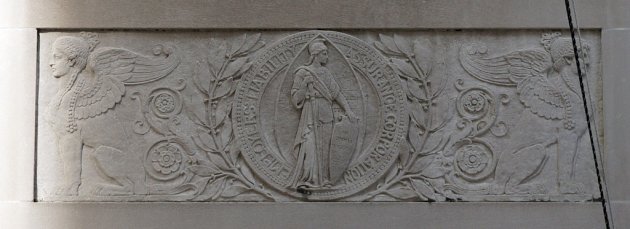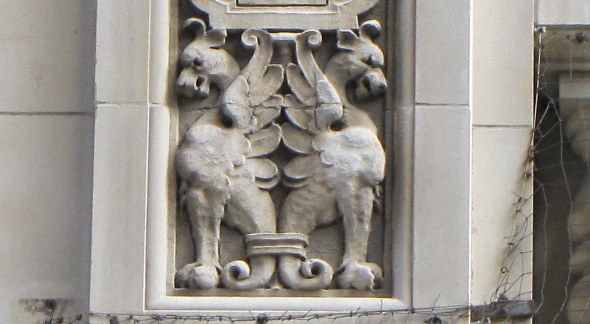Assyriously cool friezes in downtown Boston

On the Samuel Appleton Building. See it larger.
In the late 1800s, the merchant princes of Boston adorned their buildings with classical Greek and Roman symbols of successful seafaring commerce, such as Neptune's tridents and Mercury's caduceuses (Mercury being the god of trade and all).
And then, it stopped. Maybe it was the decline of Boston as a seaport, but whatever the reason, in the 20th century, financial firms took over from trading companies and turned to an even older culture - the Assyrians - for symbolism on their new buildings.
The Samuel Appleton Building, named for a prominent Boston insurance executive and built in 1926 at 1 Liberty Sq., boasts, among other things, a pair of lamassus - chimerical Assyrian symbols of power that combine the wisdom of a royal, the strength of a lion and the wings needed to survey one's dominion (and, yes, these are the things ISIS is busy destroying in Iraq).
The United Shoe Machinery Corporation Building on Federal Street is one of Boston's best (and few) examples of art-deco design. Built in 1928, it features some amazing scroll work above its entrance, in both concrete and gold, including these specimens:


The rear of the Boston Five Cents Savings Bank (now the Walgreens) along Province Street is unusual because it has both Greek and Assyrian symbolism, often in the same shield, such as this one with winged lions:

Anybody know when it was built?
The R.H. Stearns building, at Tremont Street and Temple Place, had some winged dogs (?) with snake's tails, made part of the design when built in 1909:

These winged whatever-they-ares adorn the entrance to the Rice Building at 10 High St., built in 1914:

Ad:

Comments
Hippogriffs?
I think the whatever-they-ares may be hippogriffs:
https://www.google.com/search?q=hippogriff&tbm=isch
bottom pic
Those look like griffins/gryphons.
When people used to have a
When people used to have a classical education in school these symbols meant something. Nowadays the meaning its lost as education no longer focuses on wrote historic symbolism in ancient cultures as a foundation of understanding the world.
If ornament hadn't been culled from architecture by an ungodly alliance of cheapskate capitalists and "we must escape history to build a utopia" German Marxists mid 20th century our buildings would be covered in the universal pop culture symbols of the current era.
In other words our buildings would be covered in internet meme statuary, lol cats, hash tags, emoticons, and celebrities. Can you imagine architectural styles derived from the most popular YouTube channels?
Suddenly the precast boxes in the seaport are looking pretty good!
Grumpy Cat de Milo
has a nice ring to it.
Internet Meme Statuary (band name!)
Sort of like how Washington National Cathedral has a grotesque of Darth Vader.
Boston Five Building
My memory is telling me that the Boston Five building at DTX is comparatively recent. I seem to remember it was built in the early 70s (maybe 1971?) specifically to be the main branch of the Boston Five. As such, it's only ever been a Boston Five, maybe another bank after that (?), Border's and now Walgreens. Anyone got the specifics?
The front half of the building
The one with the glass and concrete, yeah, that was built in 1972. A retrospective.
But the rear part of the building, onto which it was grafted, which you can still see along School and Province streets, dates a lot farther back.
Boston Five Cents Savings Bank
The original bank was constructed in 1925 - http://mhc-macris.net/Details.aspx?MhcId=BOS.1971
See also: 101 and 75 Federal
101 is a modern 1980s building, 75 was built in the late 1920s and is extremely ornate inside and out. The conjoined buildings are open to the public, and you can walk through 75 and see all the rich brass and marble details. Walking around it, you will see some extremely ornate friezes.
http://www.publicartboston.com/content/bronze-panels
What are new Ch. 40B projects adorned with?
Bike racks?
This!
This is the reason why UniversalHub has been one of the anchors in the sea of newswires that I follow. This site and most of the contributors have some of the most sound local news reporting, but more importantly, profile the character of the city in which its constituents report the news and participate in their day-to-day. I don't like to read newswires for breaking stories, "some sources familiar to the story say," or "alleged" accusations. News reporting often overlooks history, and in the midst of all of the cabin fever, this was an unexpected break from everything. You should start a section for content like this post here. Great work.
Thanks for the kind words!
You'll find the historical stuff on the History page.
116 Huntington
Could be the last building to be built with architectural friezes. If you look up, there are two figures, Ceres I think, up near the top. That means it has been 25 years+ since there has been any real ornamentation on a commercial building in Boston. 111 Huntington doesn't count. Too cheesy, neither does the pre-freezing on Bespa Han Solo slab tribute on the back of 45 Province.
What god should go on our buildings
Could be that archaeology was exposing this material to Europe and the USA at the same time as it was seeking sources of Eastern mystical power as shown in symbolist painting. Then it gets expressed by industrialists who were attracted to this particular story of power. The men who built these buildings were proud to think of themselves as conquering leaders of their society.
As a practitioner of ornamental arts, I would be interested to see what our current captains of industry could come up with if they turned their thoughts away from their bullshit startup and towards their built legacy. At the very least they would put artists back to work and make our surroundings more interesting and less disposable.
The difficulty is they would have to think about what they want to be, what they aspire to, and then through reading find symbols that have meaning for them. People who run big companies now have little literacy in this kind of thing which is why we live in an architecturally impoverished age.
People make lots of money now by disrupting this society and exporting our wealth. If they truly wanted a divine being on their buildings it would be that god who throws the golden apple into the ladies cocktail party, and the god who takes it from there, Mars the god of war.
The old AT&T building has all
The old AT&T building has all that bronze art deco with pictograms of hermes and electrcity and all that. Pretty amazing art deco design